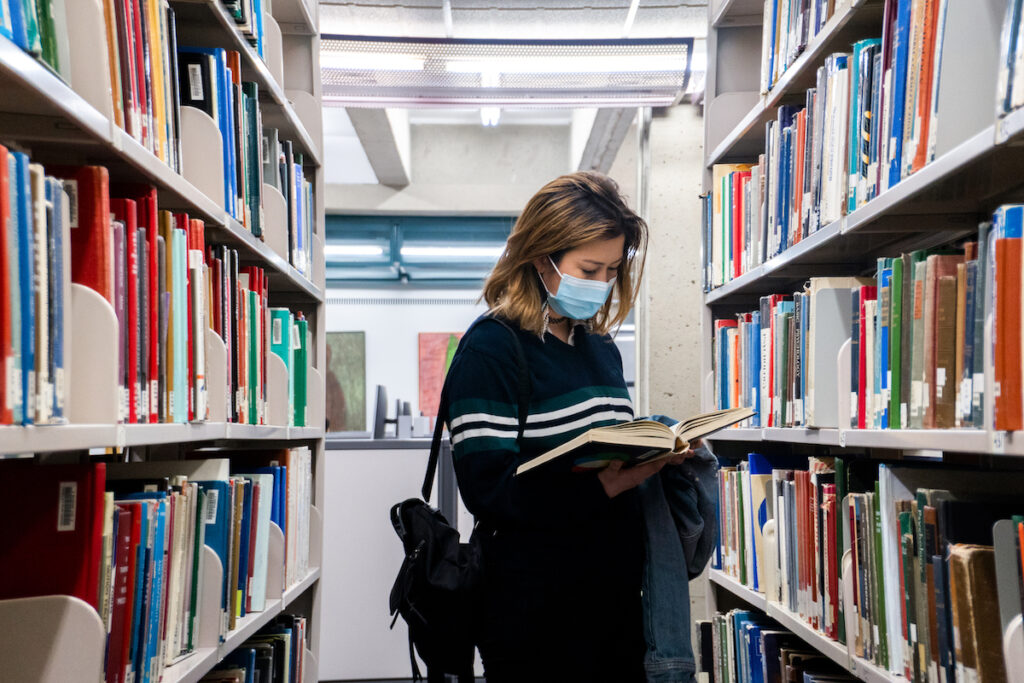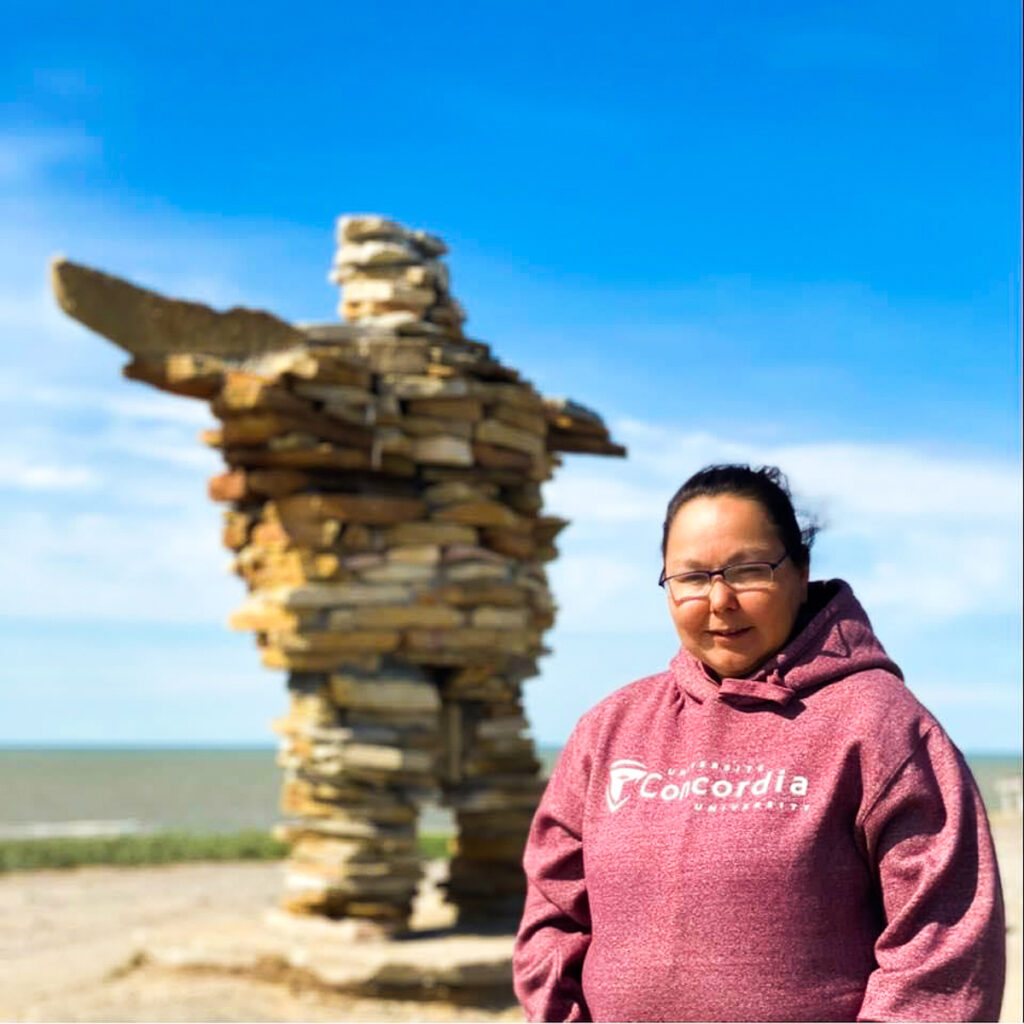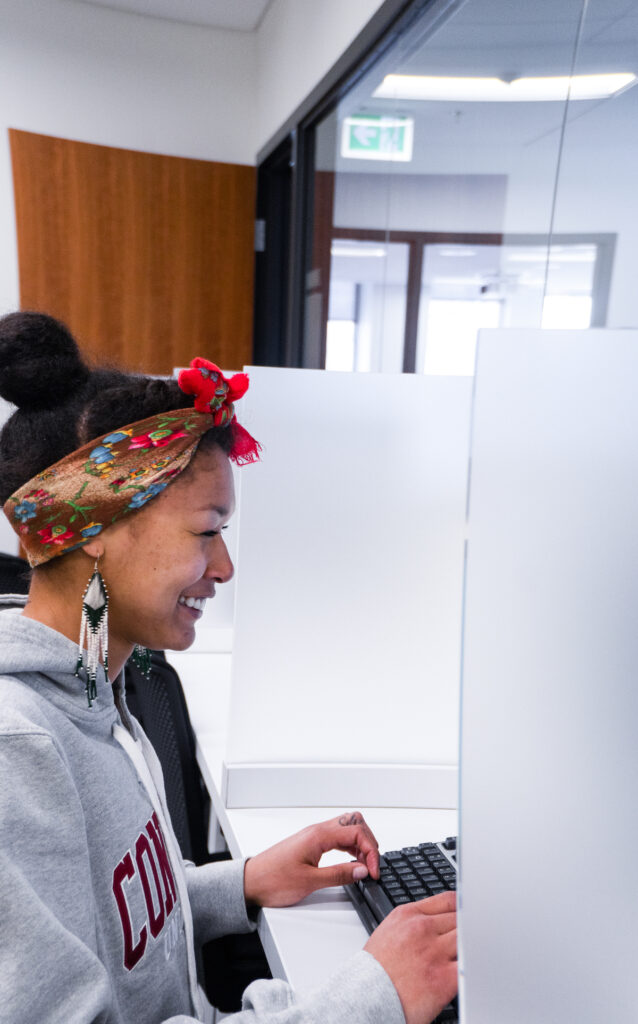Students from Quebec’s northernmost region go through thick and thin to have post-secondary education. Four of them shared how they surmounted these challenges and what the future holds for them.
On decisive days, ambitious Inuit students board Canadian North or Air Inuit-tagged planes with most of their belongings, saying goodbye to their families and hometowns.
Watching from their porthole, the lakes, rocky meadows and forests slowly dissolve into houses, highways, buildings and towers.
Between 1,100 to 1,900 kilometres separate Nunavik communities and Montreal. A select few decide to tackle this challenge in the pursuit of post-secondary studies.
Nunavik is Quebec’s northernmost region. It has 14 Inuit communities, Kuujjuaq being the most populous with around 3,000 inhabitants. Students from these communities must leave the region to access post-secondary studies.
Four students shared their stories with The Concordian.
The system in place
Before diving into the student’s stories, we need to summarise the system that is in place for them. Nunavik students wishing to pursue post-secondary education in the south must first apply for a sponsorship at the Post-Secondary Student Services department of Kativik Ilisarniliriniq, which translates as ‘school board in English’.
The institution provides financial, social, and academic support for students when moving to wherever they want to study.
However, even with all the support provided by Kativik Ilisarniliriniq, profound challenges remain.
The Kativik School Board estimates that “three per cent of Inuit have a diploma of college studies, compared with 37.4 per cent for Quebec as a whole. The rate for a certificate, diploma or university degree is two per cent compared to 30.9 per cent for Quebec overall.”
In 2018, Quebec’s Ombudsman reported that, “Despite promising initiatives, access to postsecondary studies remains difficult” in Nunavik.
As a previous post-secondary director, Annahatak admits that seeing these statistics can be “quite disheartening.”
From his understanding, part of the problem is that “the few students who graduate high school are like superstars” in their communities. “They were the big fish in a small pond,” he said. “When they come here, they become a very small fish in a huge ocean, and that’s a big hit to the ego.”
Another problem is the lack of support post-secondary students have at the community level.
Annahatak said that students “do not get a lot of support for coming to school in general.” Having been a director, he mentioned, “I knew there were some students who were actively discouraged from going to college.”
Because of this, Annahatak said that “there are no role models” for post-secondary students to look up to. He points out that the few graduates who are engineers or lawyers were raised and educated in the south, putting them into a separate category altogether.
Michelle Smith, Métis Cinema-Communications teacher at Dawson College and principal investigator for the First Peoples’ Post-secondary Storytelling Exchange research project (FPPSE), interviewed dozens of Indigenous students studying away from their home communities. A few of them were from Nunavik.
Smith provided another perspective on the situation.
“On the one hand, [students] are trying to navigate the western system of learning to acquire skills that they did not build in high school,” she explained. “On the other hand, they are in this place of deep questioning about who they are and who they want to be.”
She said that these two factors alone can be overwhelming for students.
This western system of learning was a prominent aspect in Smith’s research. She said that “post-secondary systems are still modelled on a certain type of learning where reading and writing are really important qualities to have.”
“I see so many brilliant, young minds who are able to talk at length about deep knowledge and understanding of their culture,” she said. However, “writing this knowledge down in a formal structured essay with all the rules and expectations is not always going to happen, and it doesn’t mean that the person is not capable.”
Both Smith’s FPPSE project and the report made by Quebec’s Ombudsman concluded that there are many problems Kativik Ilisarniliriniq should resolve for better education in Nunavik.
There are no science or math prerequisite courses in Nunavik, preventing students from partaking in science programs. Both reports suggest additional support for students to transition from high school to college and university. There should also be more post-secondary options offered in Nunavik.
With this appropriate context laid out, we can now turn to the stories provided by our students from Nunavik; looking at how their journeys started, the various challenges faced, and how they surmounted them.
The birth of purpose
From Kuujjuaq is Ayagutak May, a political science and First Peoples studies student at Concordia. Fellow Kuujjuamiut (an Inuktitut word meaning “from Kuujjuaq”) is psychology and First Peoples studies student Ulayu Sequaluk. From Kuujjuaraapik is graphic design student Daphne Tooktoo. Last but not least is Jason Annahatak from Kangirsuk. He has two master’s degrees; one in psychological counselling and the other in business. He was also the director for post-secondary services in Nunavik for four and a half years.
All of their stories began with a purpose.
May’s purpose first showed itself during her last two years of high school. Her Inuktitut teacher encouraged the school to add Inuit history as part of the educational curriculum, and it was then that she was first exposed to the realities her ancestors faced through residential schools.

“I was not fully aware of what happened to my community, especially to my community,” she said. “Knowing that my family went through a lot of hardships and trauma back in the day… that’s what motivated me into doing something more.”
“Discovering more about my heritage and colonization gave me ambition to help my community by pursuing a university degree.”
Even though Sequaluk lived in Montreal for years, she said that her purpose came when she returned home to Kuujjuaq after studying Global Makeup at Vancouver’s Blanche Macdonald Centre. She started working part time at the Nunavik Regional Board of Health and Social Services’ suicide prevention initiative.

“The work I was doing there was just more fulfilling. And given the very high suicide rate in Nunavik, I just got really tired of seeing all my friends die… so I wanted to do something about it, and I did.”
Tooktoo said that she started post-secondary studies long after graduating high school and raising her family. In 2014, she made the leap and enrolled in CEGEP. She first went to John Abbott College in the Graphic and Web Design program. Afterwards, she attended University of Victoria’s Visual Arts program in British Columbia. Now, she is continuing her degree at Concordia.
She said that “there are a lot of graphic designs on the web that are not translated into Inuktitut,” and she aims to create a larger Inuit and Indigenous presence on the web.
Annahatak’s story started with a desire for adventure. He said that he “wanted to experience something beyond high school, to live in a city and try something outside of a small town.” There are around 600 people in his hometown of Kangirsuk.
He admitted that his journey was “a bit of a winding path.” He wanted to study business, but he felt his math skills were not up to par. “I got discouraged, and went into social sciences, from there I started studying psychology.”
The pitfalls
“It was very hard to be in class with so many people and adapt to the structure of how they teach,” May shared. “Homework was very new to me; it was like a pile of things that I had no idea what to do with.”

Tooktoo said that language was her toughest hurdle. “The most challenging part was my English, because it’s my fourth language,” she said. “I grew up learning Inuit and listening to Cree people. I went to a French elementary school and then I did CEGEP in English.” During class, she often had to check her dictionary to know what everything meant.
Another core difficulty was homesickness. May said that moving out “is a very emotional moment for us because we get homesick, we miss eating our country food and going camping.” Since the city is anything but a natural environment, both of these needs cannot be fulfilled.
Sequaluk added to this point by saying, “you go from 3,000 people in your hometown to a school of over 3,000 kids in a big city, the culture shock is huge.” She added that “a lot of people quit school, not because they can’t handle it. They quit because they’re homesick.”
Annahatak faced culture shock, homesickness, and a new system of learning at the age of 16. He lived in Montreal with his parents for a year. He couldn’t wait until the year was over so that he could go back to his community.
He explained that the western system “felt sort of loud” to him. “To some extent, there is a lot of emphasis put on talking,” he said. “You have to produce, you have to be out there and make space so you can be heard.” In the Inuit world, he said “there is more emphasis put on listening, being quiet and paying attention to your environment.”
When Annahatak enrolled in CEGEP, it was a totally different story. Having been to high-school in Montreal, it gave him a head start, and he knew what he was getting himself into. However, he understood quickly that post-secondary education was also academically challenging. “It’s like going from the minor leagues to the major leagues in terms of what you need to produce and the quality of writing.”
However, in the end, all four managed to find their own strategies to make their university experiences enjoyable.
Strategies to surmount
May’s adapting process is still ongoing. But she found comfort in bringing her country food here to relieve her homesickness. Things like Tuktuk (caribou), Puijiviniq (seal meat), Iqaluk (fish), Mattak (beluga), among others, are her meals of choice.
She also added that having a child grounded her, even with all the responsibilities that come with motherhood. “Ever since I had my daughter, I am more focused on what I want to do, I am more ambitious, and she makes me feel so much better when I am down south.”
Sequaluk said, “I make a real effort to practice my Inuktitut and do cultural things while I am here, just so I don’t forget that part of my identity.” She followed by saying, “I think it’s just a balance, and I do realize not everyone handles being in the city all that well, and I don’t judge them when they go back up north.”

For Tooktoo, she doubled down on learning English. Now, she can attend school and understand university-level language without the need of a dictionary.
What helped Annahatak was his friend group. He was surrounded by fellow Inuit students who were going through similar difficulties, although he admitted that he “did not try hard enough to make friends with non-Inuit people” in CEGEP. In university, he changed that for the better.
He advised all Nunavik post-secondary students to “have a sense of exploration. Even if the homework is unpleasant, it is part of the package of socializing, having fun and learning about life,” which makes the overall experience more enjoyable.
He kept this mentality when he travelled all over the world, from South Africa to Hong Kong. That sense of exploration helped him rekindle his Inuk identity. “Once I started travelling, my identity became a source of intrigue and interest,” he shared. Some people would ask where his family name came from, and he said that “sometimes it started a really nice conversation where I got the chance to talk about Inuit people.” This made him take pride in who he was.
What’s to come
With time, the purpose that guided our storytellers through their hardships helped them form clear objectives.

May has a distinct inspiration that helps guide her on her path: her aunt Mary Simon, Canada’s governor general.
For her, Simon is a beacon of inspiration, driving her to make a change in her home community.
That change consists of joining Nunavik’s political sphere. May said, “my biggest goal would be for Nunavik to become functionally self-governing in a way that fits Inuit concepts and ways of knowing. To give a positive and thriving environment for Nunavimmiut where trauma, substance abuse, and suicide could be decreased.”
Sequaluk’s goals are about reshaping the field of psychology. If she gets a doctorate, she will create “Inuit-led and Inuit safe practices, because there is a lot of distrust within the healthcare system, especially for mental health.”
That strategy is about intertwining cultural practices with mental healing. It is called “on-the-land healing.” She followed this by saying that her method “would be to integrate on-the-land healing with psychological approaches [she] has learned in school.”
After the doctorate, she wishes to lead her own field of research and break new boundaries. However, she is aware that “a lot of academics do not regard Indigenous research as being serious. So, there is that hurdle to go over in the future.”
For Tooktoo, it’s about increasing Indigenous and Inuit presence online. She knows that by herself, it is a task that would take many lifetimes. “I want to teach at my local school,” she said. “A computer class that I will be teaching in my own language.”
While she currently makes websites and designs in Inuktitut, she wants to bring her knowledge to a new generation of young web designers to increase the online representation of Indigenous languages and art styles.
Years after graduating, Annahatak still seeks out new experiences. During his time as post-secondary director, he started his second master’s degree in business. He now works in the economical development department of the Makivik Corporation, an Indigenous organization that helps develop businesses in Nunavik.
In terms of systemic issues, Annahatak remains hopeful. He points out a couple of initiatives that have the potential to solve a few problems for post-secondary students.
He talked about Montreal’s Nunavik Sivunitsavut, a one-year bridging program that teaches skills rooted in Inuit culture. He said that it “serves as a nice incubator where students build their self-esteem and collective pride.”
He also mentioned JUMP Math Canada, an online platform that helps educate students at home. In an article for Nunatsiaq News, reporter Elaine Anselmi wrote that “It was conceived as a resource for educators to find lessons shaped by the Inuit worldview,” supporting teachers and families alike. For Annahatak, these programs are steps in the right direction.
He acknowledged that sometimes, he feels there are no improvements. “Some days, I think we are regressing.” However, he admitted that “there is very incremental progress.” Between laughs, he added, “progress that is going at a glacier’s speed!”
Photos by Cedric Gallant




